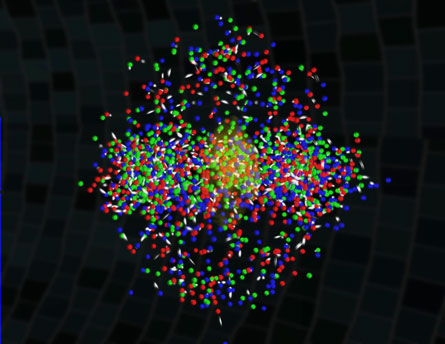The hottest soup in New York
A quark-gluon plasma reaches the highest temperature ever measured in a lab.
This winter has been a season of breaking records. Last month, athletes at the winter Olympic games in Vancouver broke sports records. A few weeks before that, record-breaking amounts of snow fell on the eastern and southern United States. And on February 15, scientists announced in Washington, D.C., that they had broken another record — for the highest temperature ever reached in a laboratory.
That new record is 4 trillion degrees Celsius (that’s 7.2 trillion degrees Fahrenheit). By doing experiments at that temperature, scientists hope to study what happened just after the universe was born. Four trillion degrees Celsius is 250,000 times hotter than the hottest part of the sun, and probably close to the temperature of the universe right after the Big Bang, the birth of the universe.
The hot stuff is called a quark-gluon plasma, and scientists found it at the Brookhaven National Laboratory on Long Island, N.Y. Using a giant instrument called the Relativistic Heavy Ion Collider, or RHIC, the scientists zoomed two gold atoms through a ring that is 2.4 miles around and smashed the atoms together — and then watched to see what came out. There was so much energy in the crash that the atoms, in a way, melted.
 |
|
Shown is a snapshot from a simulation of gold atoms colliding quickly enough to create high temperatures that “melt out” the quarks and gluons within, creating a quark-gluon plasma.
|
| Brookhaven National Laboratory |
As temperatures climb, most solids melt into liquids, and then the liquids become gas. (Some solids may go straight to gas if the conditions are right.) Ice becomes liquid water at 0º Celsius (32º Fahrenheit). At 100º C (212º F), liquid water boils into water vapor. Compared to other substances, water’s melting and boiling points are mild: Tungsten, a material used in light bulbs, doesn’t melt until 3,410º C (6,800º F).
That temperature is freezing compared to 4 trillion degrees C. At that temperature, atoms can break apart — and parts inside an atom can break apart — and then the tiny particles inside those parts can break apart. Think of an atom as a set of nesting dolls. When the largest, outer doll breaks apart, there’s another, smaller doll inside. And when that doll breaks apart … surprise! There’s another doll inside.
Similarly, at the center of every atom is the nucleus. Inside the nucleus are particles called protons and neutrons. And inside protons and neutrons are even smaller particles called quarks. Quarks are held together thanks to another kind of particle called gluons. (Gluons help to “glue” the particle together.)
The hot stuff produced at Brookhaven is a quark-gluon plasma and it spills out like a soup made of quarks and gluons. The quark-gluon plasma is a new type of matter that’s unlike solid, liquid or gas — but it kind of behaves like a liquid.
“We are extremely anxious to find out how this works,” Barbara Jacak told Science News. “Why is it a liquid?”
Jacak works at Stony Brook University in New York and is one of the scientists working on the project at Brookhaven. She helped take the plasma’s temperature. That was a difficult task because it’s hard to measure things that small. The plasma only existed for about one-trillionth of a trillionth of a second, and it was tiny, about one-trillionth of a centimeter across.
It was a very small piece of space that was super hot for a very short amount of time. In other words, you can’t just put a thermometer in it, Jacak says.
To take the temperature, the researchers watched it glow. A hot iron rod changes color from red to yellow to white as it heats up. In a similar way, the colors of light coming from the plasma changed. Based on what colors of light the soup emitted, the team figured out that the substance had reached the 4-trillion-degree record.
By studying these kinds of super-hot temperatures, scientists hope to learn more about how the universe formed. The quark-gluon plasma may look a lot like the hot and heavy goo that existed in the universe right after the Big Bang.
Experiments such as those at Brookhaven may help us understand what happened at the very beginning of the universe. But there’s a lot of work to be done, says scientist Chris Quigg of the Fermi National Accelerator Laboratory in Batavia, Ill. “These are very early days,” he told Science News. “Like many good observations, this opens up many questions.”
Going Deeper:
Sanders, Laura. 2010. “Hot and heavy matter runs a 4 trillion degree fever,” Science News, February 15. http://sciencenews.org/view/generic/id/56379/title/Hot_and_heavy_matter_runs_a_4_trillion_degree_fever
Ornes, Stephen. 2008. “The Particle Zoo,” Science News for Kids, June 25. http://www.sciencenewsforkids.org/articles/20080625/Note2.asp
Cowen, Ron. 2010. “New galaxies may be the farthest back in time and space yet.” Science News, January 30.
http://www.sciencenews.org/view/generic/id/52404/title/New-found_galaxies_may_be_farthest_back_in_time_and_space_yet
See the video and information from Brookhaven. http://www.bnl.gov/RHIC/physics.asp







